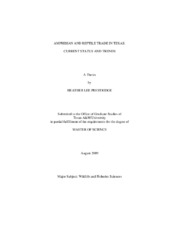| dc.description.abstract | The non-game wildlife trade poses a risk to our natural landscape, natural
heritage, economy, and security. Specifically, the trade in non-game reptiles and
amphibians exploits native populations, and is likely not sustainable for many species.
Exotic amphibian and reptile species pose risk of invasion and directly or indirectly alter
the native landscape. The extent of non-game amphibian and reptile trade is not fully
understood and is poorly documented. To quantitatively describe the trade in Texas, I
solicited data from the United States Fish and Wildlife Service's (USFWS) Law
Enforcement Management Information System (LEMIS) and Texas Parks and Wildlife
Department's (TPWD) non-game dealer permits. I surveyed amphibian and reptile pet
owners, breeders, Internet sites, pet shops, and meat and seafood establishments by
visits, electronic surveys, and observations.
The trade in exotic species of amphibians and reptiles in the state of Texas was
found to be popular in two ways; the importation of wildlife products and sale of live
specimens for pets. Persisting in the pet trade were species known to be exotic, a
problem made worse by lack of regulations governing the import, export, and keeping of exotic species. Trade in wild collected native species was primarily for export to foreign
countries. Collection of turtles from the wild in Texas was heavy until 2008, when
TPWD restricted collection to private waters. Collection of other species from the wild
was minimal, with the exception of the Western Diamond-backed Rattlsnake (Crotalus
atrox) for rattlesnake roundups. Native species were found to exist in the pet trade, but
primarily as genetic color variants that do not occur in the wild, an indication that
captive breeding may be relieving pressures on wild caught specimens.
Minor changes in reporting requirements and permitting systems at the state and
federal level would improve the management of exotic and native amphibians and
reptiles that persist in the trade. Changes that include standardized taxonomic reporting
requirements at state and federal level, streamlined permitting system for individuals
wishing to collect from the wild in Texas, bag limits and seasons for wild collection,
increased reporting requirements for owners of exotics, and enforcement of reporting
errors would aid in management of exotic and native amphibians and reptiles in the
trade. | en |


